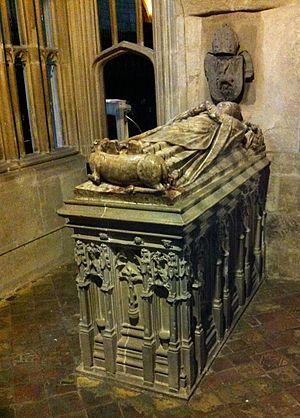Abbot of Gloucester facts for kids

Imagine a very important leader in an old monastery – that's what an Abbot of Gloucester was! This person was in charge of Gloucester Abbey, a big religious building in Gloucester, England.
Gloucester Abbey was a Benedictine monastery, meaning the monks followed special rules set by Saint Benedict. It started around the year 1022 and was dedicated to Saint Peter. Sadly, in 1377, a terrible sickness called the Black Death caused the abbey to lose about a quarter of its monks.
Later, in 1540, King Henry VIII decided to close many monasteries, including Gloucester Abbey. This event is known as the Dissolution of the Monasteries. The very next year, the abbey building became Gloucester Cathedral, which it still is today!
Contents
What Was an Abbot?
An abbot was the head of a monastery for monks. Think of them as the principal of a school, but for monks! They were responsible for everything:
- Leading the monks in prayer and daily life.
- Managing the abbey's land and money.
- Making sure everyone followed the rules.
- Representing the abbey to the outside world.
It was a very important and powerful job in medieval times.
A Look at Gloucester Abbey's History
Gloucester Abbey had a long and interesting history before it became a cathedral.
How it Started
The abbey was founded around 1022. It was a place where monks lived, studied, and prayed. They followed the Rule of St. Benedict, a set of guidelines for monastic life.
Facing the Black Death
In 1377, a huge challenge hit the abbey. The Black Death, a terrible plague, swept across Europe. It caused many deaths, and Gloucester Abbey lost about a quarter of its monks. This would have been a very difficult time for the people living there.
Becoming a Cathedral
The abbey's time as a monastery ended in 1540. This was during the Dissolution of the monasteries, when King Henry VIII closed many religious houses in England. The king took control of their lands and wealth. However, Gloucester Abbey was lucky. Instead of being destroyed, it was turned into Gloucester Cathedral in 1541. This means the beautiful building is still used for worship today!
The Abbots of Gloucester Abbey
Here is a list of the important leaders, or abbots, who guided Gloucester Abbey through its history:
| List of abbots of Gloucester | ||
|---|---|---|
| Name | Dates | Notes |
| Eadric | 1022–1058 | also known as Edric |
| Wulfstan | 1058–1072 | also known as Wilstan; died on pilgrimage to Jerusalem; related to Aldred, Archbishop of York. |
| Serlo | 1072–1104 | |
| Peter | 1107–1113 | |
| William Godemon | 1113–1130 | |
| Walter de Lacy | 1130–1139 | |
| Gilbert Foliot | 1139–1148 | afterwards Bishop of Hereford (1148–1163) and Bishop of London (1163–1187). |
| Hamelin | 1148–1179 | |
| Thomas Carbonel | 1179–1205 | |
| Henry Blont | 1205–1224 | also known as Henry Blunt |
| Thomas of Bredon | 1223–1228 | |
| Henry Foliot | 1228–1243 | |
| John de Felda | 1243–1263 | |
| Reginald de Homme | 1263–1284 | |
| John de Gamages | 1284–1306 | |
| John Thoky | 1306–1328 | |
| John Wygmore | 1328–1337 | |
| Adam of Staunton | 1337–1351 | |
| Thomas Horton | 1351–1377 | |
| John Boyfeld | 1377–1381 | |
| Walter Froucester | 1381–1412 | |
| Hugh of Morton | 1412–1420 | |
| John Morwent | 1420–1437 | |
| Reginald Boulers | 1437–1450 | afterwards Bishop of Hereford (1450–1453) and Bishop of Coventry and Lichfield (1453–1459). |
| Thomas Sebroke | 1450–1457 | |
| Richard Hauley | 1457–1472 | |
| William Farley | 1472–1498 | |
| John Malvern | 1498–1500 | |
| Thomas Braunche | 1500–1510 | |
| John Newton | 1510–1514 | |
| William Parker or Malvern | 1514–1539 | |
| Source(s): | ||

